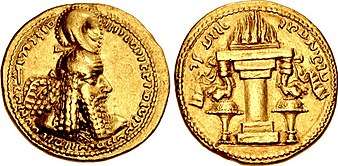Sasanian coinage
Sasanian coinage was produced within the domains of the Iranian Sasanian Empire (224–651). Together with the Roman Empire, the Sasanian Empire was the most important money-issuing polity in Late Antiquity.[1] Sasanian coinage had a significant influence on coinage of other polities.[2][1] Sasanian coins are a pivotal primary source for the study of the Sasanian period, and of major importance in history and art history in general.[2][3] The Sylloge nummorum Sasanidarum is the most important primary work of reference for Sasanian coins.[2]
Context
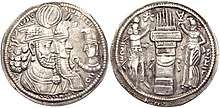

The main denomination of the Sasanians, introduced by King Ardashir I (r. 224–242) and inherited from the Parthians, was the silver drachm (Middle Persian: drahm).[2][4] Most Sasanian rulers also issued fractional silver and copper coins.[2][3] Some of these fractional coins include the hemidrachm, the obol and the tetradrachm.[3] Ardashir I had most likely inherited the hemidrachm and the obol from the monetary system of his home province, Persis (i.e. Pars).[3]
However, the tetradrachm already fell into disfavor in the early Sasanian period, during the reign of Bahram I (271-74), as it was mostly made out of copper with only a tiny bit of silver.[4] Hemidrachms also only appeared at the beginning of the Sasanian period.[4] Obols and hemiobols were used for a longer period, but they were only sporadically used for special occasions (e.g. investiture gifts, throwing in crowds).[4] Production of the hemidrachms and tetradrachms eventually ceased under Bahram II (r. 274-93), but the Iranian variant of the obol, the dang (which is the Middle Persian word), was minted until the end of Kavad I's reign (488–96, 498–531).[4][5]
Gold coins were produced in limited amounts and were mainly minted "for purposes of publicity and to compete with Roman and Kushan gold".[2] Gold dinars (Middle Persian: dēnār, ultimately from Latin denarius aureus) were also introduced by Ardashir I, the first Sasanian ruler.[6][3] Gold knowns are unknown to the Parthian monetary system, the predecessors of the Sasanians.[3] Gold Sasanian coins weighed between 7 and 7.4 grams until Shapur III's reign (383–388).[6] Minting of copper coins was very limited in the Sasanian Empire.[5]
During over four hundred years of Sasanian history, minting coins was a sole privilege of the ruling royal, and the typology employed on Sasanian coinage was invariably the same in every part of the empire; this shows that Sasanian mints were under tight control of the royal central authorities.[2][3] Other than being used for paying taxes, the precise context of Sasanian coinage as money within the empire remains unclear.[2] However, it is known that a large part of Sasanian coinage was used to pay soldiers and troops.[4] Therefore, according to Philippe Gignoux and Michael Bates, Shapur II (r. 309–379) and Peroz I (r. 459–484) "must have" increased coin production during their reigns, as they conducted numerous campaigns.[4] Massive quantities were minted under Kavad I, Khosrow I (r. 531–579) and Khosrow II (r. 590–628), who were involved in high-profile wars.[4] All Sasanian coins were hand struck, and, like in the Roman Empire, coin production was regulated according to "accurate and well-organized plans".[3]
Iconography and typology

Sasanian coins show a very consistent type of iconography, from the 3rd century to the 7th century, "though in point of style its portraits and reverses become progressively stylized". In the words of Rebecca Darley and Matthew Canepa:[2]
Coins usually bore the royal portrait on the obverse and a fire altar with two attendants on the reverse, Sasanian coins contained multiple rims, and late Sasanian coins characteristically included astral symbols outside the rims. Legends were in Pahlavi. They include the name and titles of the King of Kings on the obverse and on the reverse the phrase ‘fire of (name of king)’ and, at times, a slogan. Minting location is occasionally indicated. Each king adopted a personal crown with divine and astral symbols. These were, by and large, unique to him. Exceptions are in cases of an initial co-regency (e.g. Ardashir I and Shapur I) and in the late Sasanian period when crowns become very stylized and often similar. If a king suffered a serious defeat, he might adopt a new crown (e.g. Narseh).
Sasanian coinage of Sindh
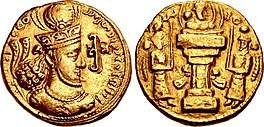
The Sasanian coinage of Sindh refers to a series of Sasanian-style issues, minted from 325 to 480 CE minted in Sindh, in the southern part of modern Pakistan, with the coin type of successive Sasanian Empire rulers, from Shapur II to Peroz I.[7] Together with the coinage of the Kushano-Sasanians, these coins are often described as "Indo-Sasanian".[9] They form an important part of Sasanian coinage.
Influence on coinage of other polities
According to Darley and Canepa, Sasanian coinage was used extensively in trade, especially with Central Asia and China, and it formed a model for types struck in areas adjacent to the Sasanian Empire, including areas ruled by the Hepthalites and Kidarites.[2] Following the Arab conquest of Iran, the Umayyad Caliphate copied Sasanian coinage but typically added some Arabic legends to the coins.[2] However some coins of this period were struck without any Arabic text.[10] These so-called Arab-Sasanian coins were minted in the heartlands of the former Sasanian Empire and followed Sasanian motives, including the depiction of the Zoroastrian fire altar.[2][10] When during the reign of Abd al-Malik ibn Marwan (r. 685–705) a new "aniconic" Muslim coinage was created, the new Islamic silver dirham still "owed its distinctive silver fabric and wide flan to Sasanian minting techniques".[2]
 Sasanian coin of Umayyads
Sasanian coin of Umayyads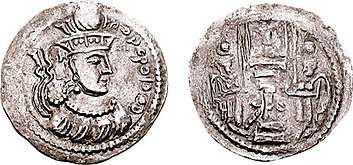 Sasanian coin of Kidarites
Sasanian coin of Kidarites An early Alchon Huns coin based on a Sasanian design, with bust imitating Sasanian king Shapur II. Dated 400-440 CE.[11][12][13][14]
An early Alchon Huns coin based on a Sasanian design, with bust imitating Sasanian king Shapur II. Dated 400-440 CE.[11][12][13][14]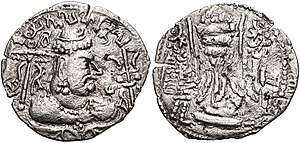 Coin of Mihirakula with legend in the Indian Gupta script. Rev: Dotted border around Fire altar flanked by attendants in the Sasanian style.[15][16][17]
Coin of Mihirakula with legend in the Indian Gupta script. Rev: Dotted border around Fire altar flanked by attendants in the Sasanian style.[15][16][17] Uncertain Hunnic chieftain derived from the Sasanian coinage of Sindh. Sind. 5th century
Uncertain Hunnic chieftain derived from the Sasanian coinage of Sindh. Sind. 5th century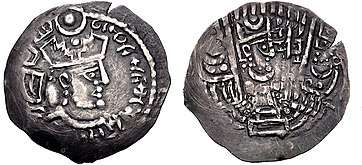 Sasanian coin of Bukhar Khudahs
Sasanian coin of Bukhar Khudahs
Indo-Sasanian coinage (530 to 1202 CE)
There is also a whole category of Indian coins, in the "Indo-Sassanian style", that were derived from the Sasanian design in a rather geometric fashion, among the Gurjaras, Pratiharas, Chaulukya-Paramara and Palas from circa 530 CE to 1202 CE. Typically, the bust of the king on the obverse is highly simplified and geometric, and the design of the fire altar, with or without the two attendants, appears as a geometrical motif on the reverse of this type of coinage.[18][19]
 Coin of the Gurjara Confederacy, on the model of the Sasanian coinage of Sindh. Sindh. Circa 570-712 CE
Coin of the Gurjara Confederacy, on the model of the Sasanian coinage of Sindh. Sindh. Circa 570-712 CE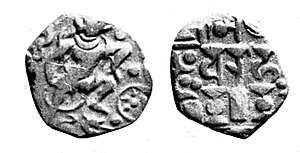 Gurjara-Pratihara coinage of Bhoja or Mihara, King of Kanauj, 850-900 CE. Obv: Boar, incarnation of Vishnu, and solar symbol. Rev: "Traces of Sasanian type". Legend: Srímad Ādi Varāha "The fortunate primaeval boar".[20]
Gurjara-Pratihara coinage of Bhoja or Mihara, King of Kanauj, 850-900 CE. Obv: Boar, incarnation of Vishnu, and solar symbol. Rev: "Traces of Sasanian type". Legend: Srímad Ādi Varāha "The fortunate primaeval boar".[20] A Chaulukya-Paramara coin, circa 950-1050 CE. Stylized rendition of Chavda dynasty coins: Indo-Sassanian style bust right; pellets and ornaments around / Stylised fire altar; pellets around.[21]
A Chaulukya-Paramara coin, circa 950-1050 CE. Stylized rendition of Chavda dynasty coins: Indo-Sassanian style bust right; pellets and ornaments around / Stylised fire altar; pellets around.[21]
References
- Darley 2018, p. 1044.
- Darley & Canepa 2018, p. 367.
- Schindel 2005.
- Gignoux & Bates 1995a, pp. 424-428.
- Album, Bates & Floor 1992, pp. 14-41.
- Gignoux & Bates 1995b, pp. 412-416.
- Schindel, Nikolaus; Alram, Michael; Daryaee, Touraj; Pendleton, Elizabeth (2016). The Parthian and Early Sasanian Empires: adaptation and expansion. Oxbow Books. pp. 126–129. ISBN 9781785702105.
- Senior, R.C. (2012). "Some unpublished ancient coins" (PDF). Oriental Numismatic Society. 170 (Winter): 17.
- Ray, Himanshu Prabha (2019). Negotiating Cultural Identity: Landscapes in Early Medieval South Asian History. Taylor & Francis. pp. 177–178. ISBN 9781000227932.
- Bates 1986, pp. 225-229.
- Braarvig, Jens (2000). Buddhist Manuscripts (Vol.3 ed.). Hermes Pub. p. 257. ISBN 9788280340061.
- For one of these coins
- Tandon, Pankaj (2013). "Notes on the Evolution of Alchon Coins" (PDF). Journal of the Oriental Numismatic Society (216): 24–34. Retrieved 2018-07-08.
- CNG Coins
- Verma, Thakur Prasad (2018). The Imperial Maukharis: History of Imperial Maukharis of Kanauj and Harshavardhana (in Hindi). Notion Press. p. 264. ISBN 9781643248813.
- Sircar, D. C. (2008). Studies in Indian Coins. Motilal Banarsidass. p. 376. ISBN 9788120829732.
- Tandon, Pankaj (2013). Notes on the Evolution of Alchon Coins Journal of the Oriental Numismatic Society, No. 216, Summer. Oriental Numismatic Society. pp. 24–34. also Coinindia Alchon Coins (for an exact description of this coin type)
- Ray, Himanshu Prabha (2019). Negotiating Cultural Identity: Landscapes in Early Medieval South Asian History. Taylor & Francis. pp. 162–163. ISBN 9781000227932.
- "The Indo-Sassanian coins, also termed as Gadahiya and circulated from 600 to 1200 A.D., are found in good numbers from Ahmadahad, Banaskantha, Bhavanagar, Junagarh, Kaira, Kutch, Mehsana, of Gujarat." in The Journal of Academy of Indian Numismatics & Sigillography. Academy of Indian Numismatics & Sigillography. 1988. p. 145.
- Smith, Vincent Arthur; Edwardes, S. M. (Stephen Meredyth) (1924). The early history of India : from 600 B.C. to the Muhammadan conquest, including the invasion of Alexander the Great. Oxford : Clarendon Press. p. Plate 2.
- Post-Gupta (Chaulukya-Paramara) coin, Classical Numismatic Group.
Sources
- Album, Stephen; Bates, Michael L.; Floor, Willem (1992). "COINS AND COINAGE". Encyclopaedia Iranica, Vol. VI, Fasc. 1. pp. 14–41.CS1 maint: ref=harv (link)
- Bates, Michael (1986). "ARAB-SASANIAN COINS". Encyclopaedia Iranica, Vol. II, Fasc. 3. pp. 225–229.CS1 maint: ref=harv (link)
- Darley, Rebecca; Canepa, Matthew (2018). "coinage, Persian". In Nicholson, Oliver (ed.). The Oxford Dictionary of Late Antiquity. Oxford: Oxford University Press. ISBN 978-0-19-866277-8.CS1 maint: ref=harv (link)
- Darley, Rebecca (2018). "money". In Nicholson, Oliver (ed.). The Oxford Dictionary of Late Antiquity. Oxford: Oxford University Press. ISBN 978-0-19-866277-8.CS1 maint: ref=harv (link)
- Gignoux, Philippe; Bates, Michael (1995b). "DINAR". Encyclopaedia Iranica, Vol. VII, Fasc. 4. pp. 412–416.CS1 maint: ref=harv (link)
- Gignoux, Philippe; Bates, Michael (1995a). "DIRHAM". Encyclopaedia Iranica, Vol. VII, Fasc.4. pp. 424–428.CS1 maint: ref=harv (link)
- Schindel, Nikolaus (2005). "SASANIAN COINAGE". Encyclopaedia Iranica.CS1 maint: ref=harv (link)
